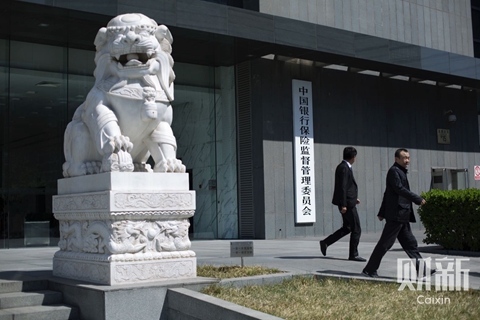Top Financial Regulator Names 26 Department Chiefs

China’s top banking and insurance regulator Monday named the key officials of its 26 functional departments, concluding a major overhaul of the country’s financial regulatory system.
Several sources close to the China Banking and Insurance Regulatory Commission (CBIRC) told Caixin that the leadership appointments were announced at an internal meeting Monday, the first working day after the week-long National Holiday. Some department heads remained in place and others were promoted, transferred or removed.
Reshuffling and official appointments at local CBIRC offices are expected be completed by the end of this year. The current heads of local offices will meet in Beijing in a few days, sources told Caixin.
The CBIRC is one of the first agencies to complete its reorganization under a broader government revamp approved by the cabinet in March. As part of the overhaul, the CBIRC was created by merging the China Banking Regulatory Commission (CBRC) and the China Insurance Regulatory Commission (CIRC).
The creation of the CBIRC is the biggest reorganization in China’s financial regulatory system since the CBRC was spun off from the central bank in 2003. It is a major effort to fix flaws in China’s fragmented regulatory system, built around the central bank and three regulatory commissions overseeing banking, insurance and securities. The old regulatory structure faced increasing problems dealing with financial institutions exploiting gaps and loopholes to carry out risky and sometimes shady business practices.
Caixin reported in August that the CBIRC unveiled detailed plan to reorganize its departments and personnel. The plan clearly defined the leadership, institutional structure and organizational responsibilities of the commission. In the combination of agencies, the CBIRC consolidated the 37 departments of the former CBRC and CIRC into 26 functional departments.
The CBIRC is still dealing with the aftermath of the downfall of former CIRC Chairman Xiang Junbo and former CBRC Assistant Chairman Yang Jiacai, which affected the candidates for certain key positions, sources said.
As previously reported, the CBIRC will no longer have an assistant chairman, but instead has appointed four chief officers, overseeing risk control, inspection, legal affairs and accounting.
Xiao Yuanqi, former director of the CBRC’s prudential regulation bureau, was named the chief risk officer; Yang Liping, former director of the CBRC’s large-scale bank department, was appointed chief inspection officer; Liu Fushou, former legal affairs head of the CBRC, will be the chief legal counsel; and Ma Xueping, former chief accountant of the CIRC, was designated the chief accountant of the CBIRC.
Xiao was also appointed director of the general office of the CBIRC, which oversees the commission’s daily administrative operations. Yang remains the director of the CBIRC’s large-scale bank department. Liu also serves as the director of the CBIRC’s Beijing Office to replace retired director Su Baoxiang.
Among officials who were removed, Yu Longwu, who was involved in Yang Jiacai’s corruption case, was replaced by Zhao Jiangping as the director of joint-stock banking department. Caixin has learned that Yu submitted his official resignation before the National Day holiday.
In July, Yang Jiacai was sentenced to 16 years of imprisonment for taking bribes and amassing “enormous assets that can’t be accounted for.” He informed investigators of the misconduct of other officials, Caixin learned. Some CBRC officials who were close to him have been assigned to other posts outside the regulatory system, sources with knowledge of the matter told Caixin previously.

- 1China Sets 2026 Economic Priorities With Demand Revival at the Core
- 2In Depth: China Bad-Debt Managers’ Bet on Bank Stocks Could Backfire
- 3Beijing Moves to Rein in Steel Exports With New Licensing Rule
- 4China Eases Rare Earth Curbs With First Export Licenses
- 5China Ramps Up Effort to Offload Vast Supply of Unsold Homes
- 1Power To The People: Pintec Serves A Booming Consumer Class
- 2Largest hotel group in Europe accepts UnionPay
- 3UnionPay mobile QuickPass debuts in Hong Kong
- 4UnionPay International launches premium catering privilege U Dining Collection
- 5UnionPay International’s U Plan has covered over 1600 stores overseas




